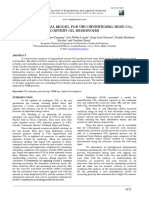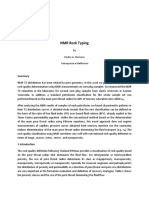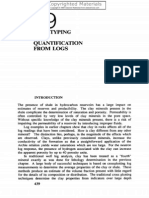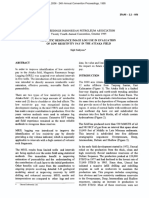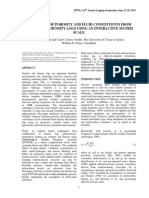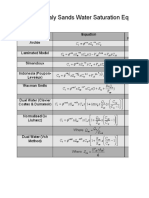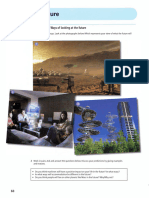Tarek Hamed
Tarek Hamed
Uploaded by
Ruaa Mohamed RayanCopyright:
Available Formats
Tarek Hamed
Tarek Hamed
Uploaded by
Ruaa Mohamed RayanOriginal Description:
Copyright
Available Formats
Share this document
Did you find this document useful?
Is this content inappropriate?
Copyright:
Available Formats
Tarek Hamed
Tarek Hamed
Uploaded by
Ruaa Mohamed RayanCopyright:
Available Formats
Nature and Science 2015;13(4)
http://www.sciencepub.net/nature
Petroleum evaluation through subsurface and petrophysical studies of Hammam Faraun Member of Belayim
Formation, Bakr Oil Field, Gulf of Suez, Egypt
Abd Elhady, M. A.1, Fathy, M.1, Hamed, T. 2 and Reda, M.1
1
Geology Department, Faculty of Science, Al Azhar University, Cairo, Egypt.
2
General Petroleum Company, Cairo, Egypt
Abstract: Bakr Oil Field is located at the western coast of the Gulf of Suez. The Middle Miocene Hammam Faraun
Member of Belayim Formation is considered to be a good reservoir in the study area. The present work mainly deals
with the interpretation of geological and geophysical data to evaluate the hydrocarbon potentials of Belayim reefal
limestone reservoir in Bakr Oil Field. Isopach, lithofacies and structural maps are constructed to study the
subsurface configuration of the study area based on the well-log correlations and seismic interpretation. Wire-line
logs, from four drilled wells in the study area are interpreted for petrophysical evaluation. Analytical reservoir rock
analysis includes achieving the shale content (Vsh), effective porosity (eff), water and hydrocarbon saturation (Shr &
Sw), and net-pay thickness variation. Also, the vertical and horizontal variations of reservoir parameters are studied
through constructing the litho-saturation cross plots and iso-parametric maps of the study area. As a result of the
present study, using the subsurface and petrophysical evaluation, the hydrocarbon potentials of the Middle Miocene
Belayim Formation in Bakr Oil Fields is determined. A new locations is recommended to be a prospect in the study
area.
[Abd Elhady, M. A., Fathy, M., Hamed, T. and Reda, M. Petroleum evaluation through subsurface and
petrophysical studies of Hammam Faraun Member of Belayim Formation, Bakr Oil Field, Gulf of Suez,
Egypt. Nat Sci 2015;13(4):59-78]. (ISSN: 1545-0740). http://www.sciencepub.net/nature. 10
Keyword: subsurface structure, petrophysical studies and Hammam Faraun Member.
This study is carried out by using the computer
software programs, such as Petrel 2010 software
program
(@schlumberger,
2010),
Interactive
Petrophysics
version
3.5
software
program
(@schlumberger, 2008).
Notice: To complete this study we looked at
another of some other wells in the study area.
Subsurface Geologic Setting
Geologic setting of the study area is determined
by reviewing the general stratigraphy and structural
relations, using subsurface data with the aid of isopach,
lithofacies and structural maps.
1- Subsurface Stratigraphy
The lithostratigraphic units in the Gulf of Suez
area range from Precambrian to Holocene in age and
have been divided into three major related tectonic rift
sequences: Pre-rift lithostratigraphic sequence (PreMiocene unit), Syn-rift lithostratigraphic sequence
(Miocene unit) and Post-rift lithostratigraphic sequence
(Post-Miocene unit). Figure (3) shows a generalized
stratigraphic column of Bakr Oil Field in the Gulf of
Suez.
The Pre-rift succession disconformably overlies
the basement rocks and unconformably underlies the
Miocene sequence. The Pre-rift stratigraphic sequence
is composed of strata range from Precambrian to Late
Eocene and contains sandstone, shale and carbonate
facies that were laid down under terrestrial and marine
platform environments. This period of sedimentation
1. Introduction
Bakr Oil Field was one of the first commercials
oil fields and the most prolific in the Gulf of Suez.
Figure (1) shows that the Bakr Oil Field is located at
the western coast of the Gulf of Suez, between latitudes
28 47 - 28 40 N and longitudes 32 91 - 33 00. It is
located about 10 kms north of Gharib Oil Field, and
about 40 kms north of Ras Shukheir Oil and Gas Field.
Figure (2) shows the distribution of the available
seismic lines and wells in the study area.
2. Materials and Methodology:
The present study mainly depends on the use of
the available open-hole well log records (electric,
radioactivity and sonic logs) in the form of composite
well logs (Resistivity, SP, GR, Density, Neutron and
Sonic) of four wells distributed in the area of study. In
addition to this, twenty 2D and 3D seismic lines are
used to delineate the subsurface structural setting.
The subsurface geologic setting is gained through
the construction of isopach maps, lithofacies maps,
seismic sections, structural cross sections and structure
contour maps.
The petrophysical evaluation is gained through
the computer processed interpretation that passes
through the quantitative interpretation technique. The
petrophysical characteristics are illustrated laterally (in
the form of iso-parametric maps) and vertically (in the
form of litho-saturation cross-plots).
59
Nature and Science 2015;13(4)
http://www.sciencepub.net/nature
was affected by major unconformities representing
non-depositional or erosion at different geologic times.
The Syn-rift lithostratigraphic sequence was
previously subdivided into two main groups "Ghrandal
Group" and "Ras Malaab Group". The Miocene section
in Gulf of Suez is mainly related to the Lower and
Middle Miocene, while the Upper Miocene deposits are
previously believed to be missed as a result of a major
unconformity between the Middle Miocene and the
Pliocene deposits. Recent publications supported the
presence of Upper Miocene evaporite deposits in many
areas in the Gulf of Suez (Ryan and Hsu, 1973 and
Haq et al., 1987). The Post-rift sedimentary fill of Gulf
of Suez is Pliocene-Holocene in age. The thickness and
lithology of these strata show marked variation from
one area to another.
The post Miocene strata consist of sandstone,
shale and limestone. The strata were deposited in a
shallow to deep marine setting.
Stratigraphic Setting of Belayim Formation
Belayim Formation is conformably overlying the
Kareem Formation and underlying the South Gharib
Formation. It represents the oldest strata in Ras Malaab
Group. It represents the beginning of the main Miocene
evaporite cycle and it is composed of thick bed of
white, to grey, hard crystalline anhydrite intercalated
with grey, to green, soft to medium hard shale and fine
to medium grained sandstone. The clastic and
carbonate section represents good target for oil
reservoir in the Gulf of Suez. The evaporitic sequence
represents an excellent seal and cap rocks for
underlying oil reservoir (EGPC, 1974).
In the study area, Belayim Formation consists
mainly of reefal limestone with some shale streaks, but
in some wells it is distinguished into four members that
have different identities. Feiran and Baba members
consist of anhydrite and shale embedded by Sidri
Member of shale with limestone interbeds and overlain
by Hammam Faraun Member of reefal limestone and
shale.
Figure (1): Location map of Bakr Oil Field.
60
Nature and Science 2015;13(4)
http://www.sciencepub.net/nature
Figure (2): The distribution of the available seismic lines and wells in the study area.
61
Nature and Science 2015;13(4)
http://www.sciencepub.net/nature
Figure (3): Generalized stratigraphic section in Bakr Oil Field after (GPC, 2013).
Baba Member is composed of anhydrite and shale
interbeds (mostly one bed). It is the lower member of
Belayim Formation, which is conformably, overlies the
Kareem Formation.
Sidri Member is the lower clastic member of Belayim
Formation, which is composed of calcareous shale
intercalated with limestone.
Feiran Member is composed of thick bed of anhydrite
with minor shale streaks. It is the thickest member of
Belayim Formation in the study area.
Hammam Faraun Member is the youngest member
of Belayim Formation, mainly composed of reefal
limestone with shale at few wells. Its type section is
selected at Wadi Ghrandal, north of Gebel Hammam
Faraun. This member is affected by facies changes and
remarkable lithological variation all over the Gulf of
Suez. It consists of sandstone, shale, and limestone.
The stratigraphic correlation, (figure 4), runs in
the northwest-southeast direction passing through the
wells in the study area, using Belayim Formation as a
datum line. This stratigraphic correlation shows that the
62
Nature and Science 2015;13(4)
http://www.sciencepub.net/nature
thickness of Belayim Formation increases in the
northwestern and southeastern parts and reach its
maximum thickness at Bk-102 well with 76m and
decreases towards the central part of the study area at
Bk-75 with 38m.
Figure (5) shows the isopach map of Hammam
Faraun Member of Belayim Formation. It shows that
the thickness of Hammam Faraun Member of Belayim
Formation increases in the western part of the study
area and decreases in the central part of the area. The
basinal area is directed to the western part of the study
area recording its maximum thickness in the western
part, while the platform occurs in the northwestern and
central parts of the study area.
Lithofacies map of Hammam Faraun Member of
Belayim formation:
According to Warner (1977), lithofacies map is a
map showing the distribution of different types of rock
attributes or facies occurring within a designated
geologic unit.
In the study area, The Nullipore facies in Bakr
area is described based on well-log data analysis. The
Belayim carbonates are dated to Hammam Faraun
Member. The Hammam Faraun Member of Belayim
Formation is mainly composed of reefal limestone
termed Nullipore with some highly calcareous shale
interbeds.
Facies distribution map of Hammam Faraun
Member of Belayim Formation (Nullipore zone) shows
distribution of reefal limestone at most of the area
especially along the eastern and central parts of the
study area, and shows gradual change laterally to
calcareous shale to the western part where the
upthrown side of the horst block is found (Fig.6).
Hammam Faraun Member of Belayim Formation
lithofacies map is characterized by the presence of
three lithologic groups, as follows:
The first lithologic group is limestone. It is
located in the northeastern part of the study area (at
Bakr-75 well). In this part the sand /shale ratio is 0%,
while the clastic/non-clastic ratio is 0.16%. The second
lithologic group is Lime-shale. It is located in the
central and northwestern parts of the study area (at
Bakr-91 and Bakr-102 wells). In this part the sand
/shale ratio ranges from 0.3%in Bakr-102 to 0.6% in
Bakr-91, while the clastic/non-clastic ratio ranges from
0.4% in Bakr-91 to 0.8% in Bakr-102. The third
lithologic group is shale-lime. It is located in the
southern part of the study area (at Bakr-100well). In
this part the sand /shale ratio is 0.9%, while the
clastic/non-clastic ratio is 0.5%.
Figure (4): NW-SE correlation section in the study area.
63
Nature and Science 2015;13(4)
http://www.sciencepub.net/nature
Figure (5): Isopach map of Hammam Faraun Member of Belayim Formation.
Figure (6): Lithofacies map of Hammam Faraun Member of Belayim Formation.
Seismic interpretation implies detection of the
subsurface structural configuration. To understand the
geology and subsurface structure of the area under
investigation, the interpretation of several seismic
sections would be done. To understand the subsurface
structure of the study area, twelve dip seismic sections
are constructed and oriented towards NE-SW direction,
and eight strike seismic sections are constructed and
oriented towards NW-SE direction as is shown in
figure (2). The interpreted seismic sections 4, 7, and 12
are shown in figure (7), which are dip seismic sections
and take the NE-SW trend. Seismic section-4 is located
at the southern part of the study area and passes near
2- Structural setting of Bakr area
To get a real structural pattern in the study area,
well-logging and seismic data are needed. Moustafa
(1976) defined Bakr area within the second down
faulted block (Belayim province). This province is
characterized by a strong deformation and exhibits a
rather complex intersection of fault pattern, mainly
Suez (clysmic) and Aqba trend (Van der ploeg, 1953).
The cross-sections reflect the structural image
vertically but it is completed by the construction of
structural model and structural maps, to illustrate the
structural feature laterally.
Seismic Interpretation
64
Nature and Science 2015;13(4)
http://www.sciencepub.net/nature
Bakr-100 well. Seismic section-7 is located at the
central part of the study area and passes near Bakr-91
well. Seismic section-12 is located at the northern part
of the study area and passes near Bakr-91 well. The
interpretation of these sections is done by using the
time-depth chart constructed using checkshot data of
Bakr-100 well, so the detection of the two way time of
the selected stratigraphic horizon is easily done. These
sections pass through the studied rock units (Zeit
Formation, South Gharib Formation, Hammam Faraun
Member of Belayim Formation, Feiran Member of
Belayim Formation, Lower Miocene formations and
Lower Senonian Matulla Formation). These sections
show a set of two normal faults (F1 and F2) forming a
horst block that affects on all the stratigraphic units. F1
and F2 are directed towards the NW-SE trend forming
a horst block that would be an excellent location for oil
and gas accumulations.
Structure contour maps
Figure (7): NE-SW interpreted seismic sections.
65
Nature and Science 2015;13(4)
http://www.sciencepub.net/nature
Structure contour map on top Lower
Miocene formations.
Structure contour map on of Lower
Senonian Matulla Formation.
Structure contour map on top Feiran
Member of Belayim Formation.
Structure contour map on top Hammam Faraun
Member of Belayim Formation.
Structure contour map on top South Gharib Formation
Structure contour map on top Zeit Formation
Figure (8): Structure contour maps on top of selected rock units in Bakr Oil Field.
After the interpretation of the seismic sections we
construct structure contour maps for each of the
selected stratigraphic horizons by using Petrel 2010
software program (@ Schlumberger, 2010(.To
illustrate the subsurface structural configuration of the
study area, six structure contour maps are constructed
on top of selected rock units (Zeit Formation, South
Gharib Formation, Hammam Faraun Member of
Belayim Formation (reservoir in the study area), Feiran
Member of Belayim Formation, Lower Miocene
formations, and Lower Senonian Matulla Formation) as
is shown in figure (8). These maps show a set of two
normal faults (F1 and F2) which are determined from
the interpreted seismic sections. F1 and F2 form a horst
66
Nature and Science 2015;13(4)
http://www.sciencepub.net/nature
block that would be an excellent location for oil and
gas accumulations. F1 and F2 are taking the NW-SE
direction with a down-thrown side towards the NE and
SW directions respectively. All the studied wells are
located on the horst block and located within the threeway dip closure that is very suitable place for oil and
gas accumulations.
Mekkey (2012) mentioned that the uplifting caused
due to rift tectonic during the Eocene and some of
structures during the Early Miocene time. This may
indicate that the area was affected by faults in PreMiocene and rejuvenated during the Miocene time.
Structural model of the study area
To delineate the subsurface structure of the study
area, structural model is constructed and also structural
cross sections are done through the study area in
different directions. Figure (9) shows that the structure
affecting the study area is mainly normal faults forming
a horst block which would be an attractive trap for oil
and gas accumulations.
Figure (9): Structural model which constructed in the area of study.
and hydrocarbon saturation are required to be
evaluated, which together define the amount of
hydrocarbons per unit volume of rock. Petrophysics, in
its simplest form, is the calculation of porosity and
fluid saturations as a function of depth in a well (Luthi,
2001).
In this study, the petrophysical analysis was
performed for four wells restricted in the central part of
the study area (Bakr-75, Bakr-91, Bakr-100 and Bakr102).
The value of formation water resistivity (Rw) for
Belayim Formation is obtained from the composite-log
data at Sw equals 100%, by using the Archie's water
saturation equation (Schlumberger, 1987). Another
method for determining Rw is the using of "Pickett
plot", which is developed by plotting porosity values
with deep resistivity values on two-by-three cycle log-
Structural Cross Sections
Four structural cross sections have been
constructed using the interpreted seismic lines. Figure
(10) shows the structural cross sections which reflect
that the study area was affected by two normal faults
F1 and F2, forming a horst block. F1 is directed
towards the NW-SE trend and its downthrown side is
directed towards the NE trend. F2 is also directed
towards the NW-SE trend and its downthrown side is
directed towards the SW trend.
Petrophysical Evaluation
This part of the study is concerned with the
petrophysical characteristics of reservoir rock units in
Bakr Oil Field, Gulf of Suez, Egypt. We need to
evaluate the reservoir in the term of petrophysical
parameters of both rock and fluid constituents. In order
to assess a possible petroleum reservoir, the porosity
67
Nature and Science 2015;13(4)
http://www.sciencepub.net/nature
log paper (Asquith and Gibson, 1982). The value of
formation water resistivity (Rw) for Hammam Faraun
Member of Belayim Formation ranges from 0.095
(Ohm.m.) in Bakr-100 to 0.813 (Ohm.m.) in Bakr-75.
The calculated net pay, Effective porosity, water
saturation and hydrocarbon saturation values were
tabulated and mapped for Hammam Faraun Member of
Belayim Formation (table 1). The cutoffs used are as
follows: Effective porosity 10%, Volume of shale 35%,
Water saturation 50%.
Figure (10): Structural cross sections in Bakr Oil Field.
Table (1): The Petrophysical parameters of Hammam Faraun Member of Belayim Formation in Bakr Oil
Field.
Effective
Water
Shale
Hydrocarbon
Interval
Net pay
porosity
saturation
content
saturation
Well no.
Gross (m)
( m)
(m)
(%)
(%)
(%)
(%)
Bakr-75
1520-1562
42
20
16
40
21
60
Bakr-91
1240-1379
139
5
18
75
30
25
Bakr-100
1372-1474
102
13
22
51
12
49
Bakr-102
1200-1348
148
50
19
40
27
60
Well log analysis
Well-log analysis represents the most important
stage in the evaluation of petrophysical characteristics
(effective porosity, shale content, water saturation, and
hydrocarbon saturation).
Lithological Identification cross-plot
Identification of lithology is of a particular
importance in formation evaluation process. Logs can
be used as indicators of lithology. The most useful logs
for this purpose are density, neutron, sonic and gammaray logs. Figure (11) shows the neutron-density and the
68
Nature and Science 2015;13(4)
http://www.sciencepub.net/nature
neutron-sonic cross-plots (lithological identification
cross plot) of Hammam Faraun Member of Belayim
Formation in all wells. As is shown in this figure, it is
mainly characterized by the predominance of reefal
limestone. It is also characterized by the presence of
shale.
Figure (11): Lithological identification cross plots of Belayim Formation in Bakr-100 well.
petrophysical evaluation. In this investigation, figure
(13) and figure (14) show dia-porosity cross-plot which
is carried out to determine the shale volume (Vsh) and
effective porosity (eff).
The value of shale content ranges from 12% in
Bakr-100 to 30 % in Bakr-91. It indicates the
probability of presence of hydrocarbon sub-reservoir
intervals as the mean value is 22 %, while the value of
effective porosity ranges from 16% in Bakr-75 to 22%
in Bakr-100. It indicates the probability of presence of
hydrocarbon sub-reservoir intervals as the mean value
is 19%.
Mono-Porosity cross-plot
Figure (12) shows mono-porosity cross-plot of
Hammam Faraun Member of Belayim Formation
which carried out to determine the water saturation
(Sw). The value of water saturation ranges from 40% in
Bakr-75 and Bakr-102 to 75% in Bakr-91. It indicates
the probability of presence of hydrocarbon subreservoir intervals as the mean value is 52%.
Dia-Porosity cross-plot
For the determination of shale volume (Vsh) and
effective porosity (eff), a combination of porosity logs
can be used. Dia-porosity cross-plot is a specific
graphical log analysis technique for actual
69
Nature and Science 2015;13(4)
http://www.sciencepub.net/nature
Figure (12): Mono-porosity cross-plot of Hammam Faraun Member of Belayim Formation in the wells of
study area.
70
Nature and Science 2015;13(4)
http://www.sciencepub.net/nature
Figure (13): Dia-porosity cross-plot for determining the shale volume (Vsh) of Hammam Faraun Member of
Belayim Formation.
Illustration of Petrophysical Parameters
Lateral Variation of Petrophysical Characteristics
The
lateral
variation
of
petrophysical
characteristics in the area under investigation could be
studied through a number of gradient and saturation
maps (iso-parametric maps, that include, net pay (m),
shale content (Vsh %), effective porosity (eff %), water
saturation (Sw %), and hydrocarbon saturation (Shr %)
to complete the vision of hydrocarbon potentialities in
the study area.
Belayim net pay thickness distribution map:
Figure (15) shows the net pay thickness
distribution. The net pay ranges between 5m in Bk-91
to 50m in Bk-102. The highest thickness of the pay
zone is concentrated in the central part of the study area
and decreased in the southeastern and northwestern
parts of the study area. This map indicates that the
central and northeastern parts of the study area are the
most promising parts for hydrocarbon accumulations.
71
Nature and Science 2015;13(4)
http://www.sciencepub.net/nature
Figure (14): Dia-porosity cross-plot for determining the effective porosity (eff) of Hammam Faraun Member
of Belayim Formation.
72
Nature and Science 2015;13(4)
http://www.sciencepub.net/nature
Figure (15): Net pay thickness map of Hammam Faraun Member of Belayim Formation.
Figure (16): The Effective porosity map of Hammam Faraun Member of Belayim Formation.
73
Nature and Science 2015;13(4)
http://www.sciencepub.net/nature
Figure (17): Water saturation map of Hammam Faraun Member of Belayim Formation.
Figure (18): Shale content distribution map of Hammam Faraun Member of Belayim Formation.
74
Nature and Science 2015;13(4)
http://www.sciencepub.net/nature
Figure (19): Hydrocarbon saturation map of Hammam Faraun Member of Belayim Formation.
Figure (20): The litho-saturation cross-plot of Hammam Faraun Member of Belayim Formation in Bakr-75
well.
75
Nature and Science 2015;13(4)
http://www.sciencepub.net/nature
member, the shale content ranges between 0% to 70%
and the mean value is 21%. The effective porosity
ranges between 0% to 29% but the mean value is 16%.
The water saturation ranges between 0% to 100% and
the mean value is 40%. The net pay is 20m. The
hydrocarbon saturation reaches up to 60%.
Figure (21) illustrates the computer processed
interpretation (CPI) plot for Hammam Faraun Member
of Belayim Formation in Bakr-91 well. As is shown in
this figure it is encountered at depth ranges from
1240m to 1379m. The gross interval is 139m. It is
mainly characterized by the predominance of
limestone. It is also characterized by the presence of
shale, and siltstone. Limestone tends to increase in the
central and upper part of this member. In this member
the shale content ranges between 0% to 50% and the
mean value is 30%. The effective porosity ranges
between 0% to 41% but the mean value is 18%. The
water saturation ranges between 0% to 100% and the
mean value is 75%. The net pay is 5m.
Hydrocarbon Potential
From the subsurface and petrophysical
information of this study, we can concluded the
petroleum potentialities in the study area. According to
Ashraf (1999), the source rock in the study area is
suggested to be of Lower Miocene section of
calcareous, dark grey shale and reefal limestone which
is considered as a good source rock. The reservoir rock
in the study area is represented by Hammam Faraun
Member of Belayim Formation (Middle Miocene
Serravalian age) which consists mainly of reefal
carbonate. The seal rock in the study area is
represented by the evaporite series of South Gharib and
Zeit formations. The structural traps in the study area,
are represented by fault traps. A set of normal faults F1
and F2 are present and forming a horst block.
Prospect Evaluation
According to Gluyas and Swarbrick (2004),
exploration wells are drilled into prospect. Prospects
are volumes of rock in the earth crust that are believed,
but not proven to contain the four key component: a
valid trap, an effective seal, a reservoir and petroleum
source rock that has generated and expelled petroleum
into the trap. Once an exploration well penetrates a
prospect, it ceases to be a prospect. It became a proven
petroleum field or more likely a dry hole, which means
that it lacks petroleum. A lead is nothing more than an
ill-defined prospect. The boundary between what is
lead and what is prospect is open to individual
interpretation.
As a result of the present study, using the
subsurface and petrophysical evaluation, a new
location is proposed to be a prospect as in figure (22).
The area which has the red color, is recommended to
be a prospect area according to the subsurface
petrophysical evaluation.
Belayim Effective porosity (eff %) distribution
map:
Figure (16) illustrates the effective porosity
distribution. The most frequent porosity is observed
within the range of 16% in Bk-75 to 22% in Bk-100.
The highest value of effective porosity is found at the
central and southeastern parts of the study area, while
the lowest value of effective porosity is found at the
northeastern part.
Belayim water saturation (Sw %) distribution map:
Figure (17) shows the distribution of water
saturation in the study area. The most water saturation
occurrence is observed within the range of 40% in Bk102 to 75% in Bk-91. The highest water saturation
value is found at the western and northwestern parts in
the study area while the lowest water saturation value
is found at the central and northeastern parts.
Shale content (Vcl %) variation map
Shale content is an important quantitative
function of log analysis. It is considered as an
important indicator of reservoir quality, in which the
lower the shale content usually reveals a better
reservoir. Figure (18) shows the shale content map of
Hammam Faraun Member of Belayim Formation and
illustrates that the shale content ranges from 12% in
Bk-100 to 30% in Bk-91. The shale content decreases
at the southeastern part, while it increases in the
northwestern part of the study area.
Hydrocarbon saturation variation map
Determination of hydrocarbon saturation (Shr %) is the
main target of the current study. The hydrocarbon
saturation map of Hammam Faraun Member of
Belayim Formation, figure (19), illustrates that the
hydrocarbon saturation ranges from 49% in Bakr-100
to 60% in Bakr-102. This map illustrates that the
hydrocarbon saturation in the study area increases in
the northeastern and central parts and decreases in the
northwestern part of the area.
Vertical Variation of Petrophysical Characteristics
The vertical distribution of hydrocarbon
occurrences can be explained and presented through
the construction of the litho-saturation cross-plots.
Litho-saturation cross-plot is a representation, zonewise, for the content of fluids and rocks with depth
through the studied well. The contents of rocks include
shale and matrix, while the contents of fluids include
water and hydrocarbon saturation. Figure (20)
illustrates the computer processed interpretation (CPI)
plot for Hammam Faraun Member of Belayim
Formation in Bakr-75 well. As is shown in this figure it
is encountered at depth ranges from 1520m to 1562m.
The gross interval of Belayim Formation is 42ms. It is
mainly characterized by the predominance of
limestone. It is also characterized by the presence of
sandstone and siltstone. Limestone tends to increase in
the central and lower part of the member. In this
76
Nature and Science 2015;13(4)
http://www.sciencepub.net/nature
Figure (21): The Litho-saturation cross-plot of Hammam Faraun Member of Belayim Formation in Bakr-91
well.
Figure (22): Depth structure contour map of Hammam Faraun Member of Belayim Formation and the
recommended prospect area.
77
Nature and Science 2015;13(4)
http://www.sciencepub.net/nature
Hammam Faraun Member of Belayim Formation
has a net pay thickness increasing towards the central
and northeastern parts of the study area, while the
effective porosity increases gradually into the central
and southeastern parts, the clay volume decreases
towards the northwestern and eastern parts of the study
area, while water saturation decreases towards the
central and northeastern parts of the study area, while
the hydrocarbon saturation increases gradually towards
the central and northeastern parts of the study area.
Zeit formations. The structural trap in the study area is
represented in the form of fault blocks.
As a result of the present study, using the
subsurface and petrophysical evaluation, a new
location is proposed to be a prospect area that is located
on such a three-way dip closure that is very suitable
place for hydrocarbon accumulations.
References
1. Asquith, G., and Gibson, C. (1982): "Basic well
log analysis for geologists", The American
Association of Petroleum Geologists, Tulsa,
Oklahoma, USA, 216 p.
2. EGPC Stratigraphic Committee (1974): "Miocene
rock stratigraphy of Egypt". Egypt. Journ. Geol,
18, pp.1-59.
3. General
Petroleum
Company
(2013):
"Stratigraphic setting of Bakr oil Field", internal
report, 36p.
4. Gluyas, J. and Swarbrick, R. (2004): "Petroleum
geoscience", Blackwell Science Ltd. 349 p.
5. Haq, B., Hardenbol, J. and Vail, P. (1987):
"Chronology of fluctuating sea level since the
Triassic", science, No. 236, pp. 1156-1167.
6. Luthi, S. M. (2001): "Geological Well Logs, their
use in reservoir modeling", Springer-Verlag
Berlin Heidelberg.
7. Mekkey, M. (2012): "Evaluation of hydrocarbon
potential of carbonate reservoir in Al Hamd and
Amer offshore Oil Field, Gulf of Suez, Egypt".
Ph.D. Thesis, Faculty of Science, Al Azhar Univ.,
Cairo, 191P.
8. Moustafa, A. G. (1976): "Block faulting in the
Gulf of Suez". 5th Petroleum Exploration and
Production Conference, Cairo, pp.14-38.
9. Rayan, W., and Hsu, K. (1973): "Initial report",
DSDP, V. 13, Washington (US. Convt. Printing
office) 1447 p.
10. Schlumberger (1987): "Log interpretation",
Principles
/
Application,
Schlumberger
educational services, U.S.A., 168 p.
11. Van der Ploeg, P. (1953): "The World's Oil
Fields: The Eastern Hemisphere", Egypt In: V. G
Illing (Ed.). The Science of Petroleum, Oxford
Univ. Press 6(1): pp.151-157.
12. Warner, L. (1977): "An introduction to the
technology of subsurface wastewater injection".
Municipal Environmental Research Laboratory,
U.S., 334p.
Summary and Conclusions
The present work mainly deals with the
interpretation of geological and geophysical data to
evaluate the hydrocarbon potentials of carbonate
reservoir in Bakr Oil Field, Gulf of Suez, Egypt. The
subsurface evaluation in this study was achieved by
well-log and seismic data analysis to determine both
stratigraphic and structural features as related to the
general subsurface setting of the Gulf of Suez province.
The stratigraphic succession penetrated by the
wells drilled in the study area is as the same as the Gulf
of Suez province. The structural setting is delineated by
the seismic and geologic cross-sections interpretation.
The geologic structural model was constructed to study
the structural setting in the area of study. Several
seismic and geologic cross-sections are constructed and
interpreted to illustrate the structural setting vertically.
The geologic cross sections confirm the presence of the
normal faults that are observed on the interpreted
seismic sections.
Formation evaluation in the area under
investigation was aimed to evaluate the hydrocarbon
potentialities in the porous carbonate zone that is
encountered in Middle Miocene (Nullipore of Belayim
Fm). All resulted petrophysical parameters are
represented vertically in litho-saturation cross-plots and
laterally in different types of iso-parametric maps (isoeffective porosity, shale content, hydrocarbon
saturation, and net-pay thickness variations).
From the subsurface and petrophysical
information of this study we can be in a clear vision on
the petroleum potentialities in the area of study. The
source rock in the study area is suggested to be Lower
Miocene formations based on previous studies. The
reservoir rock in the study area is the Hammam Faraun
Member of Belayim Formation which consists mainly
of reefal carbonate. The seal rock in the study area is
represented by the evaporite series of South Gharib and
3/15/2015
78
You might also like
- Dipmeter Surveys in Petroleum ExplorationFrom EverandDipmeter Surveys in Petroleum ExplorationRating: 5 out of 5 stars5/5 (1)
- Modeling The Effects of Glauconite On Some Openhole Logs From The Lower Senonian in EgyptDocument22 pagesModeling The Effects of Glauconite On Some Openhole Logs From The Lower Senonian in EgyptAlejandro Parra RojasNo ratings yet
- Log Model Development For The Bossier and Haynesville ShalesDocument14 pagesLog Model Development For The Bossier and Haynesville ShalesDavid Otálvaro Z.No ratings yet
- SCGX Fino UserguideDocument189 pagesSCGX Fino UserguideWashington JohnNo ratings yet
- PG LRP 2000Document16 pagesPG LRP 2000Sardar OvaisNo ratings yet
- Well Logging: Principles, Applications and Uncertainties: Nazmul Haque MondolDocument41 pagesWell Logging: Principles, Applications and Uncertainties: Nazmul Haque MondolHeidy CervantesNo ratings yet
- The Electrical Resistivity Log As An Aid in Determining Some Reservoir Characteristics's PaperDocument9 pagesThe Electrical Resistivity Log As An Aid in Determining Some Reservoir Characteristics's PaperKenneth BurstallNo ratings yet
- Vpvs AplicatiponsDocument6 pagesVpvs Aplicatiponspetro AliNo ratings yet
- Clay Estimation From GR and Neutron - Density Porosity LogsDocument15 pagesClay Estimation From GR and Neutron - Density Porosity LogsAlejandroNo ratings yet
- Petrophysical Interpretation in Shaly Sand Formation of A Gas Field in TanzaniaDocument13 pagesPetrophysical Interpretation in Shaly Sand Formation of A Gas Field in TanzaniaIbrahim NurrachmanNo ratings yet
- 1well Logging Methods - Unconventional Gas CharacterisationDocument19 pages1well Logging Methods - Unconventional Gas CharacterisationAdriana UrecheatuNo ratings yet
- Shaly SandDocument15 pagesShaly SandAnre Thanh HungNo ratings yet
- Determination of Total Organic Carbon Using Multivariate Regression Analysis and Wireline Logs Method at Well X, West Timor, IndonesiaDocument4 pagesDetermination of Total Organic Carbon Using Multivariate Regression Analysis and Wireline Logs Method at Well X, West Timor, IndonesiaYurry NusantaraNo ratings yet
- TOC From Well LogsDocument23 pagesTOC From Well Logslilim020776No ratings yet
- ATL 03 4307 Acoustics ApplicationsDocument39 pagesATL 03 4307 Acoustics ApplicationsSaid Nahum Montes CarballoNo ratings yet
- Quantitative Lithology SpectrosDocument14 pagesQuantitative Lithology SpectrosRosa K Chang HNo ratings yet
- New Petrophysical Model For Unconventional High-Co2 - Content Oil ReservoirsDocument13 pagesNew Petrophysical Model For Unconventional High-Co2 - Content Oil Reservoirsjorge_camargo100% (1)
- Reservoir Characterization and Identification of Formation Lithology From Well Log Data of Nahr Umr Formation in Luhais Oil Field, Southern IraqDocument10 pagesReservoir Characterization and Identification of Formation Lithology From Well Log Data of Nahr Umr Formation in Luhais Oil Field, Southern Iraqأبراهيم كريم كاظمNo ratings yet
- Nuclear Magnetic Resonance Imaging-Technology For The 21st CenturyDocument15 pagesNuclear Magnetic Resonance Imaging-Technology For The 21st Centuryfisco4rilNo ratings yet
- Iraqi Geological JournalDocument12 pagesIraqi Geological JournalAymen AlsudanyNo ratings yet
- Shaly Sand Evaluation: Assoc. Prof. Issham IsmailDocument18 pagesShaly Sand Evaluation: Assoc. Prof. Issham IsmailApiz TravoltaNo ratings yet
- 1992, Schwarzkopf - Source Rock Potential - ToC, HI - Evaluation by Integrating Well Log and Geochemical DataDocument11 pages1992, Schwarzkopf - Source Rock Potential - ToC, HI - Evaluation by Integrating Well Log and Geochemical DataJosé Rodríguez CNo ratings yet
- Subsurface MapsDocument6 pagesSubsurface MapsJovianto PrisilaNo ratings yet
- Winland 35Document7 pagesWinland 35Ivan Al-JebooreNo ratings yet
- Petrophysical FormulaeDocument3 pagesPetrophysical Formulaetayofela100% (1)
- Petrophysical Analysis ReportDocument3 pagesPetrophysical Analysis ReportjaloaliniskiNo ratings yet
- Reservoir Fluids Identification Using VpVs RatioDocument6 pagesReservoir Fluids Identification Using VpVs RatiokawanalawieNo ratings yet
- Petrophysical AnalysisDocument49 pagesPetrophysical AnalysisÖmer Faruk ÇalıovaNo ratings yet
- Ipa16 615 GDocument13 pagesIpa16 615 GSoeryawan Gilang100% (1)
- Well Logging SummaryDocument20 pagesWell Logging SummaryJavier De AndaNo ratings yet
- Petrophysical Evaluation of Mishrif Formation in X Oilfield, Southeastern IraqDocument15 pagesPetrophysical Evaluation of Mishrif Formation in X Oilfield, Southeastern IraqAymen AlsudanyNo ratings yet
- Aguilera Pickett PlotDocument23 pagesAguilera Pickett PlotFryan GreenhousegasNo ratings yet
- Iptc 17429 MSDocument18 pagesIptc 17429 MSPOOL SERVICES & SUPLLIESNo ratings yet
- Petrophysical Evaluation of Haynesville Shale ReservoirDocument24 pagesPetrophysical Evaluation of Haynesville Shale ReservoirMaclean Jacob EneotuNo ratings yet
- Petrophysics of Some Carbonates in X' Field, Central Luconia, SarawakDocument15 pagesPetrophysics of Some Carbonates in X' Field, Central Luconia, Sarawakapi-439559816No ratings yet
- Homework Assignment Well LoggingDocument10 pagesHomework Assignment Well Loggingkpratik41100% (1)
- Dr. Fadhil Lucture3Document17 pagesDr. Fadhil Lucture3ckcp7sy2ztNo ratings yet
- Nuclear Magnetic Resonance Log Evaluation of Low Resistivity Sandstone Reservoirs By-Passed by Conventional Logging AnalysisDocument6 pagesNuclear Magnetic Resonance Log Evaluation of Low Resistivity Sandstone Reservoirs By-Passed by Conventional Logging Analysisari_si100% (4)
- Rock Typing Using NMR 1Document5 pagesRock Typing Using NMR 1Herry SuhartomoNo ratings yet
- 00069632cyclic Steam Injection Pilot Yacimiento Los PeralesDocument10 pages00069632cyclic Steam Injection Pilot Yacimiento Los PeralesAndrés Eduardo Guzmán VelásquezNo ratings yet
- Crain's Petrophysical Handbook - Total Organic Carbon (TOC)Document21 pagesCrain's Petrophysical Handbook - Total Organic Carbon (TOC)RakeshKumarNo ratings yet
- Clay Typing and Quantification From LogsDocument31 pagesClay Typing and Quantification From LogsbijupiraNo ratings yet
- Evaluation of Low Resistivity Laminated Shaly Sand ReservoirsDocument5 pagesEvaluation of Low Resistivity Laminated Shaly Sand ReservoirstasaddaqYounasNo ratings yet
- RMN MRI 1995 02 Imagenes - Pozos - Baja - ResistividadDocument13 pagesRMN MRI 1995 02 Imagenes - Pozos - Baja - ResistividadLeonardo JaimesNo ratings yet
- 4.1 Lithology Identification: 4-Lithology Interpretation Using CrossplotsDocument27 pages4.1 Lithology Identification: 4-Lithology Interpretation Using CrossplotsHadirah DunglahNo ratings yet
- Lecture 4 (Porosity Logs)Document86 pagesLecture 4 (Porosity Logs)Mobeen MurtazaNo ratings yet
- Models Shaly SandDocument22 pagesModels Shaly Sandahmed_497959294No ratings yet
- Effects of Reservoir Heterogeneity in Laminated ReservoirsDocument3 pagesEffects of Reservoir Heterogeneity in Laminated ReservoirsErik Andres Garcia VillarroelNo ratings yet
- Estimation of Porosity and Fluid Constituents From Neutron and Density Logs Using An Interactive Matrix ScaleDocument12 pagesEstimation of Porosity and Fluid Constituents From Neutron and Density Logs Using An Interactive Matrix Scalereservoir_ffNo ratings yet
- 12 - Shaly Sand EvaluationDocument30 pages12 - Shaly Sand EvaluationDwisthi SatitiNo ratings yet
- Worthington, P.F.,1985 - The Evolution of The Shaly-Sand Concepts in Reservoir EvaluationDocument18 pagesWorthington, P.F.,1985 - The Evolution of The Shaly-Sand Concepts in Reservoir EvaluationJamie Myers100% (2)
- Tutorial Shaly SandsDocument12 pagesTutorial Shaly SandsMaría Angélica Garcia Giraldo100% (1)
- Badin ThesisDocument12 pagesBadin ThesisRaheelKhan0% (1)
- 4 Density-Neutron LogsDocument20 pages4 Density-Neutron Logschristine jesicaNo ratings yet
- Alternative Shaly Sands Water Saturation Equations ComparisonDocument32 pagesAlternative Shaly Sands Water Saturation Equations ComparisonKartiko WibowoNo ratings yet
- Minggu V SwdanRwDocument21 pagesMinggu V SwdanRwDesi Vivi Janna PakpahanNo ratings yet
- QAB2033 - Topic 6 - Carbonates in Arid ClimatesDocument60 pagesQAB2033 - Topic 6 - Carbonates in Arid ClimatesredwanasisNo ratings yet
- Geology of Carbonate Reservoirs: The Identification, Description and Characterization of Hydrocarbon Reservoirs in Carbonate RocksFrom EverandGeology of Carbonate Reservoirs: The Identification, Description and Characterization of Hydrocarbon Reservoirs in Carbonate RocksNo ratings yet
- Formation Testing: Pressure Transient and Contamination AnalysisFrom EverandFormation Testing: Pressure Transient and Contamination AnalysisNo ratings yet
- Basin Analysis: Principles and Application to Petroleum Play AssessmentFrom EverandBasin Analysis: Principles and Application to Petroleum Play AssessmentRating: 4.5 out of 5 stars4.5/5 (3)
- Atlas of Structural Geological Interpretation from Seismic ImagesFrom EverandAtlas of Structural Geological Interpretation from Seismic ImagesAchyuta Ayan MisraNo ratings yet
- Shobhit Nirwan Chemistry Class 11Document246 pagesShobhit Nirwan Chemistry Class 11KiraNo ratings yet
- 1126-Article Text-2341-1-10-20180412Document11 pages1126-Article Text-2341-1-10-20180412hendy herolyNo ratings yet
- Brosur 1 Cpu 2022Document1 pageBrosur 1 Cpu 2022Bachtiar Ar RachmanNo ratings yet
- Gold Energy Company Profile en - CompressedDocument6 pagesGold Energy Company Profile en - CompressedLunga MashininiNo ratings yet
- Daftar PustakaDocument2 pagesDaftar PustakaNia MaidarmiNo ratings yet
- 1/1.25 MW Inverter Training Course: September 2014Document118 pages1/1.25 MW Inverter Training Course: September 2014khbader499No ratings yet
- 03 - Science, Technology and Nation-BuildingDocument17 pages03 - Science, Technology and Nation-BuildingeclarexeNo ratings yet
- 9 JVMDocument57 pages9 JVMan.nguyenhoang2003No ratings yet
- Account STMT XX7843 14062024Document3 pagesAccount STMT XX7843 14062024cooldudee08No ratings yet
- Task 1Document4 pagesTask 1Алёнка ИвNo ratings yet
- Petroglyphs LeQuellecDocument38 pagesPetroglyphs LeQuellecAdel MeramedNo ratings yet
- LogDocument26 pagesLogmarselameiNo ratings yet
- SAGE Profile V6.3.2 User Manual - Volume 3Document55 pagesSAGE Profile V6.3.2 User Manual - Volume 3GodwinNo ratings yet
- Grade 8Document30 pagesGrade 8Ma Princess MadiaNo ratings yet
- Monitoring and Diagnostics of PV Plants by A Wireless Self-Powered Sensor For Individual PanelsDocument9 pagesMonitoring and Diagnostics of PV Plants by A Wireless Self-Powered Sensor For Individual PanelsDevil faNo ratings yet
- Course 1Document2 pagesCourse 1Tuan Anh TranNo ratings yet
- Aspects of Modern PoetryDocument6 pagesAspects of Modern Poetrymumin jamalNo ratings yet
- CSR and Private SectorDocument14 pagesCSR and Private Sectortanmaya_purohitNo ratings yet
- Bursitis/Tendinitis: DR M Arman Nasution SPPDDocument197 pagesBursitis/Tendinitis: DR M Arman Nasution SPPDdiah stanyaNo ratings yet
- Designation: D6496/D6496M - 20: Date: To: Tech Contact: Work Item #: Ballot ActionDocument2 pagesDesignation: D6496/D6496M - 20: Date: To: Tech Contact: Work Item #: Ballot ActionEdward Carhuanina LescanoNo ratings yet
- Paper Sticking To PlateDocument2 pagesPaper Sticking To PlateRocio RodriguezNo ratings yet
- Aviation Safety Thesis PDFDocument7 pagesAviation Safety Thesis PDFheidiowensspringfield100% (1)
- Francois Lelord - Cum Sa Te Iubesti Pe TineDocument28 pagesFrancois Lelord - Cum Sa Te Iubesti Pe TineSasu NicoletaNo ratings yet
- Unit-Iii Sequence and Series: 2 Marks QuestionsDocument18 pagesUnit-Iii Sequence and Series: 2 Marks QuestionsAshish Sharma0% (1)
- Advantages and Disadvantages of Technology in Our Life: Presented:By Group2Document13 pagesAdvantages and Disadvantages of Technology in Our Life: Presented:By Group2Daryn CorpusNo ratings yet
- Academic Olympics CompilationDocument9 pagesAcademic Olympics CompilationlianNo ratings yet
- Python Module 4Document115 pagesPython Module 4SANAL KUMARNo ratings yet
- Sangre Azteca Gary Jennings Descargar GratisDocument3 pagesSangre Azteca Gary Jennings Descargar GratisTri LineNo ratings yet
- 1984 Tape Recording GuideDocument73 pages1984 Tape Recording Guidejdap2000-1100% (1)
















